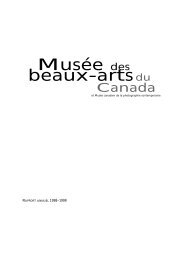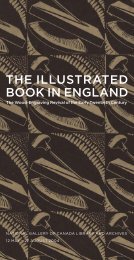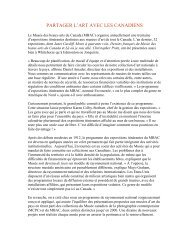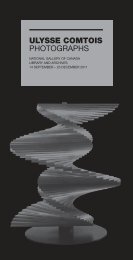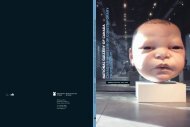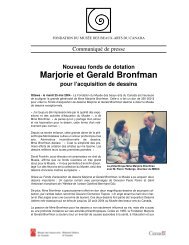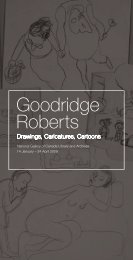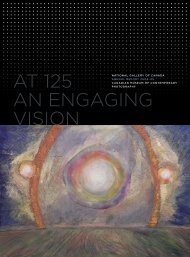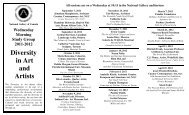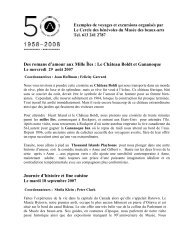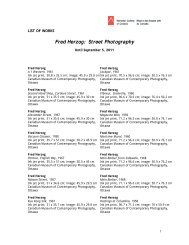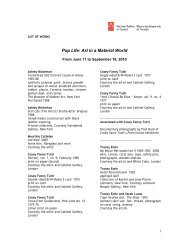The Sixties at the National Gallery of Canada
The Sixties at the National Gallery of Canada
The Sixties at the National Gallery of Canada
Create successful ePaper yourself
Turn your PDF publications into a flip-book with our unique Google optimized e-Paper software.
On February 17, 1960, <strong>the</strong> Right Honourable<br />
John G. Diefenbaker, Prime Minister <strong>of</strong> <strong>Canada</strong>,<br />
<strong>of</strong>ficially reopened <strong>the</strong> N<strong>at</strong>ional <strong>Gallery</strong> <strong>of</strong> <strong>Canada</strong><br />
in <strong>the</strong> newly built Lorne Building on Elgin Street<br />
facing Confeder<strong>at</strong>ion Square (1–3). This new<br />
loc<strong>at</strong>ion would be <strong>the</strong> <strong>Gallery</strong>’s temporary<br />
home until May 21, 1988, when it would move to<br />
its permanent loc<strong>at</strong>ion on Sussex Drive.<br />
<strong>The</strong> <strong>Gallery</strong> also had a new director, Charles Comfort, who had<br />
served as an <strong>of</strong>ficial war artist during World War II and who was, <strong>at</strong> <strong>the</strong><br />
time <strong>of</strong> his appointment, president <strong>of</strong> <strong>the</strong> Royal Canadian Academy <strong>of</strong><br />
Arts and associ<strong>at</strong>e pr<strong>of</strong>essor in <strong>the</strong> Department <strong>of</strong> Art and Archaeology<br />
<strong>at</strong> <strong>the</strong> University <strong>of</strong> Toronto. Comfort’s predecessor, Alan Jarvis, an<br />
outspoken and dynamic director, found himself a victim <strong>of</strong> partisan<br />
politics and had been forced to resign shortly before <strong>the</strong> opening <strong>of</strong><br />
<strong>the</strong> new temporary building. As part <strong>of</strong> his mand<strong>at</strong>e, <strong>the</strong> new director<br />
was expected to re-establish a sense <strong>of</strong> confidence and stability <strong>at</strong><br />
<strong>the</strong> <strong>Gallery</strong> and avoid controversy. Among his early tasks, he had <strong>the</strong><br />
pleasure <strong>of</strong> hosting a visit from Jacqueline Kennedy, who was quickly<br />
becoming an icon <strong>of</strong> <strong>the</strong> early 1960s (5).<br />
Comfort encouraged a series <strong>of</strong> biennial exhibitions <strong>of</strong> Canadian<br />
art th<strong>at</strong> sought to survey contemporary Canadian work. Although artists,<br />
particularly those who lived outside major centres, welcomed <strong>the</strong><br />
opportunity to have <strong>the</strong>ir work shown across <strong>the</strong> country and in one<br />
biennial in England, as well (12), <strong>the</strong> exhibitions proved to be a frustr<strong>at</strong>ing<br />
experience from organiz<strong>at</strong>ional and critical points <strong>of</strong> view. <strong>The</strong> seventh<br />
and last biennial was held in 1968. It did not make a substantial st<strong>at</strong>ement,<br />
nor had any <strong>of</strong> <strong>the</strong> o<strong>the</strong>rs, as too many works were included,<br />
and <strong>the</strong>y were too diverse in style and content. <strong>The</strong> goal <strong>of</strong> a n<strong>at</strong>ional<br />
look was always overridden by distinct regional and linguistic identities.<br />
Consequently, exhibitions presenting regional work, such as Five<br />
Painters from Regina (6), with its distinctive c<strong>at</strong>alogue, were much<br />
more successful.<br />
As Director <strong>of</strong> <strong>the</strong> N<strong>at</strong>ional <strong>Gallery</strong>, Comfort also served as <strong>the</strong><br />
<strong>Canada</strong> Customs arbiter for art, with <strong>the</strong> power to issue certific<strong>at</strong>es<br />
declaring any piece entering <strong>the</strong> country to be a work <strong>of</strong> art and thus<br />
exempt from import duties. In 1965 he deemed Warhol’s Brillo not art but<br />
“merchandise” and <strong>the</strong>refore subject to taxes. Th<strong>at</strong> decision resulted in a<br />
storm <strong>of</strong> neg<strong>at</strong>ive press indicting <strong>the</strong> <strong>Gallery</strong> for its inability to recognize<br />
new boundaries in art. L<strong>at</strong>er th<strong>at</strong> year Comfort retired from his position,<br />
strictly on schedule. Almost forty years l<strong>at</strong>er, Comfort’s actions still<br />
reverber<strong>at</strong>e in <strong>the</strong> art world, <strong>at</strong>tracting <strong>at</strong>tention in <strong>the</strong> press. (10–11)




